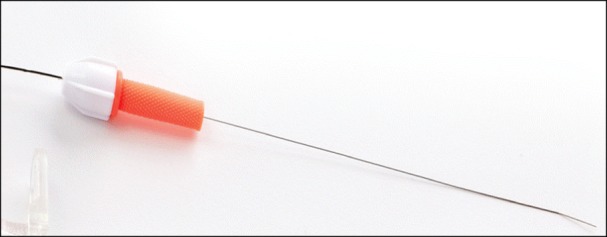Korean J Pain.
2015 Oct;28(4):287-289. 10.3344/kjp.2015.28.4.287.
Ultrasound-guided Continuous Axillary Brachial Plexus Block Using a Nerve Stimulating Catheter: EpiStim(R) Catheter
- Affiliations
-
- 1Department of Anesthesiology and Pain Medicine, Korea University Guro Hospital, Korea University College of Medicine, Seoul, Korea. clonidine@empal.com
- KMID: 2151673
- DOI: http://doi.org/10.3344/kjp.2015.28.4.287
Abstract
- Brachial plexus block (BPB) under ultrasound guidance has come to be widely used. However, nerve injury has been reported following ultrasound-guided BPB. We hypothesized that BPB under ultrasound guidance in conjunction with real-time electrical nerve stimulation would help us prevent nerve injury and do more successful procedure. Here, we report the successful induction and maintenance of ultrasound-guided BPB and the achievement of good peri- and postoperative pain control using a conductive catheter, the EpiStim(R).
Keyword
MeSH Terms
Figure
Reference
-
1. Chan VW, Peng PW, Kaszas Z, Middleton WJ, Muni R, Anastakis DG, et al. A comparative study of general anesthesia, intravenous regional anesthesia, and axillary block for outpatient hand surgery: clinical outcome and cost analysis. Anesth Analg. 2001; 93:1181–1184. PMID: 11682392.
Article2. Imasogie N, Ganapathy S, Singh S, Armstrong K, Armstrong P. A prospective, randomized, double-blind comparison of ultrasound-guided axillary brachial plexus blocks using 2 versus 4 injections. Anesth Analg. 2010; 110:1222–1226. PMID: 20142336.
Article3. Bernucci F, Gonzalez AP, Finlayson RJ, Tran DQ. A prospective, randomized comparison between perivascular and perineural ultrasound-guided axillary brachial plexus block. Reg Anesth Pain Med. 2012; 37:473–477. PMID: 22660484.
Article4. Tran DQ, Pham K, Dugani S, Finlayson RJ. A prospective, randomized comparison between double-, triple-, and quadruple-injection ultrasound-guided axillary brachial plexus block. Reg Anesth Pain Med. 2012; 37:248–253. PMID: 22354104.
Article5. Chan VW, Perlas A, McCartney CJ, Brull R, Xu D, Abbas S. Ultrasound guidance improves success rate of axillary brachial plexus block. Can J Anaesth. 2007; 54:176–182. PMID: 17331928.
Article6. Jung MJ, Byun HY, Lee CH, Moon SW, Oh MK, Shin H. Medial antebrachial cutaneous nerve injury after brachial plexus block: two case reports. Ann Rehabil Med. 2013; 37:913–918. PMID: 24466530.
Article7. Asheghan M, Khatibi A, Holisaz MT. Paresthesia and forearm pain after phlebotomy due to medial antebrachial cutaneous nerve injury. J Brachial Plex Peripher Nerve Inj. 2011; 6:5. PMID: 21896172.
Article8. Yildiz N, Ardic F. A rare cause of forearm pain: anterior branch of the medial antebrachial cutaneous nerve injury: a case report. J Brachial Plex Peripher Nerve Inj. 2008; 3:10. PMID: 18426569.
Article9. Barrington MJ, Watts SA, Gledhill SR, Thomas RD, Said SA, Snyder GL, et al. Preliminary results of the Australasian Regional Anaesthesia Collaboration: a prospective audit of more than 7000 peripheral nerve and plexus blocks for neurologic and other complications. Reg Anesth Pain Med. 2009; 34:534–541. PMID: 19916206.
Article
- Full Text Links
- Actions
-
Cited
- CITED
-
- Close
- Share
- Similar articles
-
- Bilateral variant locations of the musculocutaneous nerve during ultrasound-guided bilateral axillary brachial plexus block: A case report
- Continuous Infraclavicular Brachial Plexus Block Using Retrograde Insertion of an Epidural Catheter with Stylet through the Axilla
- Comparison of Axillary and Supraclavicular Approach in Ultrasound-Guided Brachial Plexus Block
- Continuous Axillary Brachial Plexus Block - I. Modification of Catheter insertion method -
- Ultrasound-Guided Axillary Brachial Plexus Block Performed by OIrthopedic Surgeon for Distal Radius Fracture Surgery



